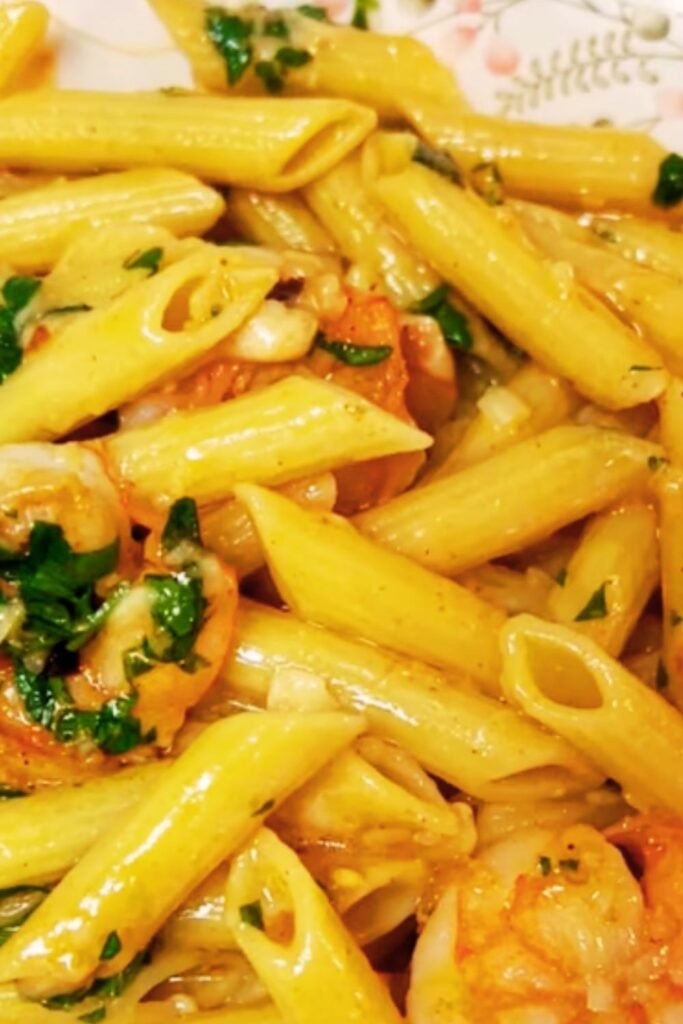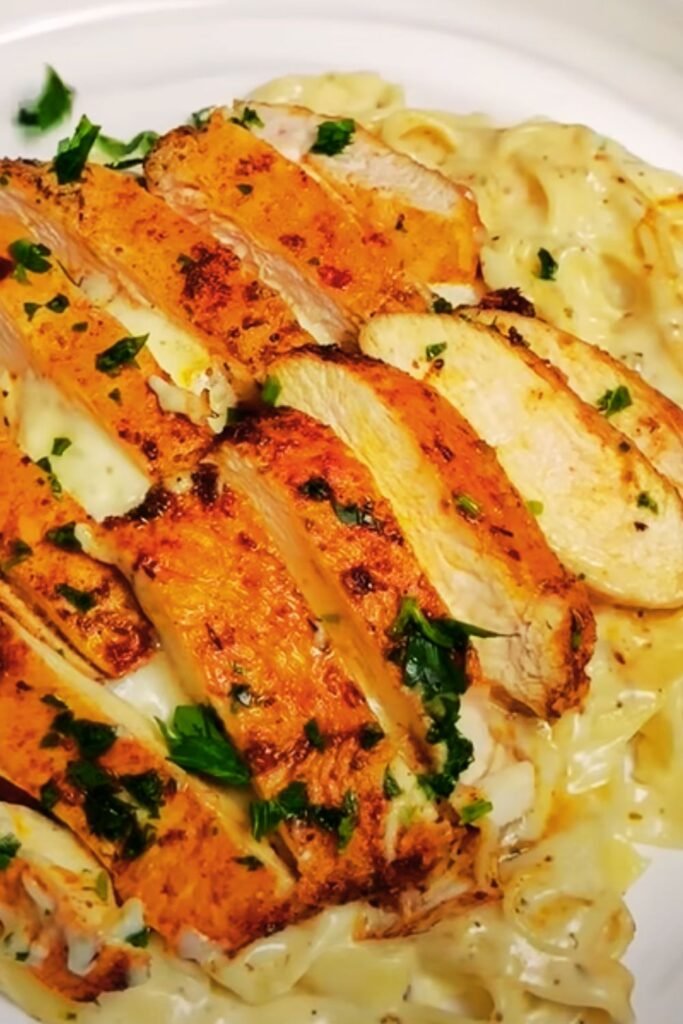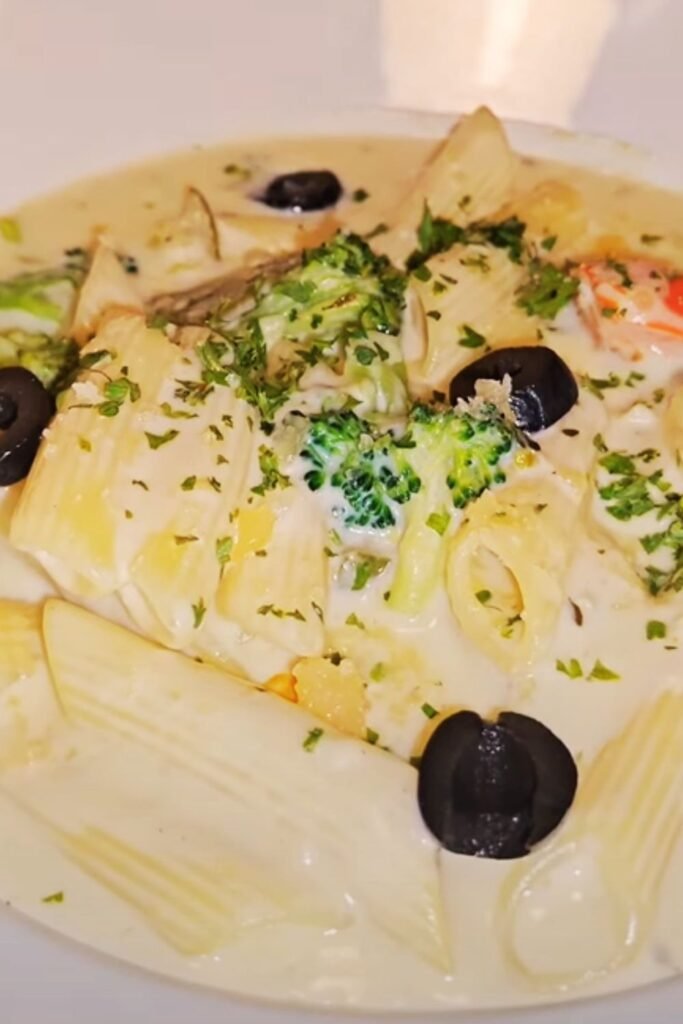There’s something absolutely magical about the combination of al dente pasta swimming in a rich, creamy garlic sauce. I’ve been perfecting my creamy garlic penne pasta recipe for years, and I’m thrilled to share every secret with you today. This dish has become my go-to comfort food, whether I’m cooking for family dinner or impressing guests at a dinner party.
The beauty of this recipe lies in its simplicity – you probably have most of the ingredients in your pantry right now. Yet the result is restaurant-quality pasta that will have everyone asking for seconds. I’ve served this dish countless times, and it never fails to deliver that perfect balance of creamy richness and aromatic garlic that makes pasta lovers swoon.
Understanding the Foundation: Key Ingredients
Before we dive into the cooking process, let me walk you through the essential components that make this dish extraordinary. Each ingredient plays a crucial role in creating the perfect harmony of flavors and textures.
Penne Pasta: The star of our show. I prefer penne because its tube shape holds the creamy sauce beautifully, ensuring every bite is perfectly coated.
Fresh Garlic: Never, and I mean never, substitute fresh garlic with powder for this recipe. The aromatic oils released from fresh garlic create the foundation of our sauce.
Heavy Cream: This is what gives our sauce its luxurious, velvety texture. I’ve experimented with lighter alternatives, but nothing matches the richness of heavy cream.
Parmesan Cheese: Freshly grated Parmigiano-Reggiano adds that nutty, salty depth that elevates the entire dish. Pre-grated cheese simply doesn’t melt as smoothly.
Butter: High-quality butter adds richness and helps create the perfect sauce consistency.
White Wine: Optional but highly recommended. It adds acidity and complexity that balances the richness beautifully.

The Perfect Pasta: Cooking Techniques That Matter
My approach to cooking pasta for this dish differs slightly from your standard boil-and-drain method. I’ve learned that the key to extraordinary pasta lies in the details that most home cooks overlook.
First, I always use a large pot with plenty of water – at least 4 quarts for one pound of pasta. This prevents the pasta from sticking together and ensures even cooking. I add salt generously, making the water taste like seawater. This is your only opportunity to season the pasta itself from the inside out.
Here’s where my technique gets interesting: I cook the penne until it’s just shy of al dente – about one minute less than the package directions suggest. Why? Because the pasta will finish cooking in the creamy sauce, absorbing those gorgeous flavors while reaching the perfect texture.
I always reserve at least two cups of pasta cooking water before draining. This starchy, salty liquid is liquid gold for adjusting sauce consistency and helping everything come together seamlessly.
Building the Perfect Garlic Cream Sauce
The sauce is where the magic truly happens, and timing is everything. I start by heating a large skillet over medium-low heat – never high heat, as we want to coax the flavors out gently without burning anything.
I add butter to the warm pan, letting it melt slowly and begin to foam slightly. This is when I add my minced garlic – usually about 6-8 cloves for one pound of pasta. The key is to let the garlic become fragrant and just barely golden, which takes about 2-3 minutes of gentle cooking.
If I’m using white wine, this is when it goes in. I let it simmer for about 2 minutes, allowing the alcohol to cook off while the wine reduces slightly. Then comes the heavy cream, which I pour in slowly while whisking constantly to prevent any curdling.

The sauce needs to simmer gently – just barely bubbling – for about 5 minutes. During this time, I gradually whisk in freshly grated Parmesan cheese, adding it in small handfuls to ensure smooth melting. The sauce should coat the back of a spoon when it’s ready.
Bringing It All Together: The Final Assembly
This is the moment where good pasta becomes great pasta. I add the slightly undercooked penne directly to the simmering cream sauce, along with about half a cup of the reserved pasta water. The starch in this water helps bind everything together while the pasta finishes cooking in the sauce.
I toss everything together using tongs, adding more pasta water as needed to achieve the perfect consistency. The sauce should coat each piece of penne without being too thick or too thin. This process usually takes about 2-3 minutes of gentle tossing and cooking.
Seasoning is crucial at this stage. I taste and adjust with salt, freshly ground black pepper, and sometimes a squeeze of fresh lemon juice to brighten everything up. Fresh herbs like parsley or basil can add a beautiful color contrast and fresh flavor note.
Nutritional Breakdown and Serving Information
Understanding what goes into your food helps you make informed decisions about portions and modifications. Here’s a comprehensive breakdown of the nutritional content per serving:
| Nutrient | Per Serving (1 cup) | % Daily Value |
|---|---|---|
| Calories | 520 | 26% |
| Total Fat | 28g | 36% |
| Saturated Fat | 17g | 85% |
| Cholesterol | 85mg | 28% |
| Sodium | 680mg | 30% |
| Total Carbohydrates | 48g | 17% |
| Dietary Fiber | 2g | 7% |
| Sugars | 3g | – |
| Protein | 18g | 36% |
| Calcium | 320mg | 25% |
| Iron | 2.1mg | 12% |
| Vitamin A | 950 IU | 19% |
| Vitamin C | 2mg | 2% |
Ingredient Variations and Substitutions
Over the years, I’ve experimented with numerous variations of this classic recipe. Here’s what I’ve learned about successful substitutions and creative additions:
| Original Ingredient | Substitution Options | Notes |
|---|---|---|
| Heavy Cream | Half-and-half + butter | Reduce richness, add 2 tbsp butter |
| Penne Pasta | Rigatoni, Fusilli, Shells | Choose shapes that hold sauce well |
| Parmesan | Pecorino Romano, Asiago | Adjust quantity as these are saltier |
| White Wine | Chicken broth | Use low-sodium variety |
| Fresh Garlic | Roasted garlic | Use 1.5x amount, sweeter flavor |
| Butter | Olive oil | Use high-quality extra virgin |
Timing and Preparation Guide
Planning is essential for perfect pasta. Here’s my detailed timeline for preparing creamy garlic penne pasta:
| Time Before Serving | Task | Details |
|---|---|---|
| 30 minutes | Prep ingredients | Grate cheese, mince garlic, measure cream |
| 20 minutes | Start pasta water | Large pot, heavily salted water |
| 15 minutes | Begin sauce | Melt butter, cook garlic |
| 12 minutes | Add pasta to boiling water | Cook 1 minute less than package directions |
| 10 minutes | Add wine/cream to sauce | Simmer gently, whisk in cheese |
| 8 minutes | Drain pasta, reserve water | Keep pasta slightly undercooked |
| 5 minutes | Combine pasta and sauce | Toss with pasta water as needed |
| 0 minutes | Serve immediately | Garnish and enjoy hot |
Common Mistakes and How to Avoid Them
Through years of making this dish, I’ve encountered every possible mistake – and learned from each one. Let me save you some heartache by sharing the most common pitfalls and how to avoid them.
Overcooking the Garlic: This is probably the most frequent error I see. Burnt garlic tastes bitter and will ruin your entire sauce. Keep the heat at medium-low and watch carefully. The garlic should smell amazing and turn just barely golden.
Adding Cheese Too Quickly: Dump all the Parmesan in at once, and you’ll get a clumpy, stringy mess instead of a smooth sauce. Add it gradually, whisking constantly, and keep the heat gentle.
Overcooking the Pasta: Remember, the pasta continues cooking in the sauce. If you cook it to perfect al dente in the water, it’ll be mushy by the time you serve it.
Sauce Too Thick or Thin: This is where that reserved pasta water becomes crucial. Too thick? Add pasta water gradually. Too thin? Let it simmer a bit longer, or add more cheese.
Not Seasoning Properly: Cream dulls flavors, so you need to season more than you think. Taste constantly and adjust with salt, pepper, and perhaps a touch of lemon juice for brightness.

Creative Variations and Add-Ins
While the classic version is perfection on its own, I love experimenting with additions that complement the creamy garlic base without overwhelming it.
Protein Additions: Grilled chicken breast, pan-seared shrimp, or crispy pancetta all work beautifully. I cook these separately and fold them in at the end to maintain their texture.
Vegetable Enhancements: Sautéed mushrooms, roasted cherry tomatoes, or blanched asparagus add color and nutrition. Sun-dried tomatoes provide an interesting sweet-tart contrast to the rich cream.
Herb Variations: Fresh basil, parsley, or chives stirred in just before serving add brightness. I sometimes infuse the cream with fresh thyme or rosemary for a more complex flavor profile.
Spice It Up: A pinch of red pepper flakes or a dash of white pepper can add subtle heat without overwhelming the delicate garlic flavor.
Storage and Reheating Guidelines
Let’s be honest – leftover creamy pasta is never quite the same as fresh, but I’ve developed techniques to make reheated pasta surprisingly good.
Refrigerator Storage: Store leftovers in an airtight container for up to 3 days. The sauce will thicken significantly as it cools, which is completely normal.
Reheating Methods: I never use the microwave for reheating cream-based pasta. Instead, I add the pasta to a pan with a splash of milk or cream and a little butter. Heat gently over low heat, stirring frequently, until warmed through. You might need to add a bit more liquid to restore the proper consistency.
Freezing Considerations: While possible, I don’t recommend freezing cream-based pasta dishes. The dairy can separate when thawed, resulting in a grainy texture that’s difficult to fix.
Wine and Beverage Pairings
Choosing the right beverage to accompany your creamy garlic penne enhances the entire dining experience. The rich, creamy nature of this dish calls for drinks that can either complement or cut through the richness.
For those who enjoy alcoholic beverages, a crisp white wine like Pinot Grigio or Sauvignon Blanc provides excellent acidity to balance the cream. A light-bodied Chardonnay that’s not too oaky also works beautifully.
Non-alcoholic options that pair wonderfully include sparkling water with lemon, iced tea with a splash of lemon, or even a well-crafted lemonade. The key is choosing something with enough acidity to cleanse the palate between bites.
Serving Suggestions and Presentation
Presentation matters, even for comfort food. I always warm my serving bowls or plates – hot pasta deserves a hot plate. A simple way to do this is to run them under hot water and dry them just before plating.
I like to garnish each serving with a sprinkle of freshly grated Parmesan, a crack of black pepper, and a few fresh herb leaves. A light drizzle of good olive oil around the edge of the plate adds visual appeal and a touch of extra richness.
For side dishes, I keep things simple to let the pasta shine. A crisp green salad with lemon vinaigrette cuts through the richness beautifully. Garlic bread is classic but can be overwhelming with an already garlic-heavy dish – I prefer a simple crusty bread or focaccia.
Seasonal Adaptations
While this recipe is perfect year-round, I love adapting it to showcase seasonal ingredients. In spring, I might add fresh peas and asparagus. Summer calls for cherry tomatoes and fresh basil. Fall brings possibilities like roasted butternut squash or sautéed mushrooms. Winter is perfect for the classic version, perhaps with some crispy pancetta for extra richness.
Questions and Answers
Q: Can I make this dish ahead of time for a dinner party?
I wouldn’t recommend making the complete dish ahead of time, as cream sauces don’t hold well. However, you can prep all your ingredients in advance – grate the cheese, mince the garlic, and measure out the cream. You can even make the sauce base (without the pasta) and gently reheat it when ready to serve, then add the freshly cooked pasta.
Q: My sauce keeps breaking or looking curdled. What am I doing wrong?
This usually happens when the heat is too high or you add the cheese too quickly. Always keep your heat at medium-low, and add grated cheese gradually while whisking constantly. If your sauce does break, try whisking in a tablespoon of cold butter or a splash of cold cream to help bring it back together.
Q: Can I use pre-grated Parmesan cheese from the store?
While you can, I really don’t recommend it. Pre-grated cheese contains anti-caking agents that prevent smooth melting, often resulting in a grainy sauce. Fresh grating takes just a few minutes and makes an enormous difference in the final texture and flavor.
Q: How do I know when my pasta is perfectly al dente?
Al dente means “to the tooth” in Italian – the pasta should have a slight firmness when you bite into it, without being hard or crunchy. Start testing a minute or two before the package directions suggest, and remember for this recipe, you want it slightly underdone since it finishes cooking in the sauce.
Q: Can I make this recipe dairy-free?
You can attempt dairy-free versions using coconut cream and nutritional yeast, but honestly, the result will be quite different from the original. The dairy is really central to this dish’s character. If you need dairy-free, you might be better served looking for a recipe specifically designed to be dairy-free from the start.
Q: What’s the best way to reheat leftover creamy garlic penne?
Never use the microwave – it will make the sauce separate and become grainy. Instead, put the pasta in a skillet with a splash of milk or cream and a pat of butter. Heat gently over low heat, stirring frequently, until warmed through. You may need to add a bit more liquid to restore the proper consistency.
Q: Can I substitute the heavy cream with something lighter?
You can use half-and-half mixed with a bit of butter, but the sauce won’t be as rich or stable. Milk won’t work well as it’s too thin and likely to curdle. If you want to lighten the dish, I’d recommend serving smaller portions with a big salad rather than compromising the sauce.
Q: Why does my garlic sometimes taste bitter?
Garlic becomes bitter when it’s cooked at too high heat or for too long. Always use medium-low heat and cook just until fragrant and lightly golden. If you accidentally burn the garlic, start over – there’s no fixing bitter garlic, and it will ruin your entire dish.
This creamy garlic penne pasta recipe has become one of my most treasured dishes, and I hope it brings as much joy to your kitchen as it has to mine. The key to success lies in patience, quality ingredients, and not being afraid to taste and adjust as you go. Remember, cooking is about creating experiences and memories – so relax, enjoy the process, and savor every creamy, garlicky bite.